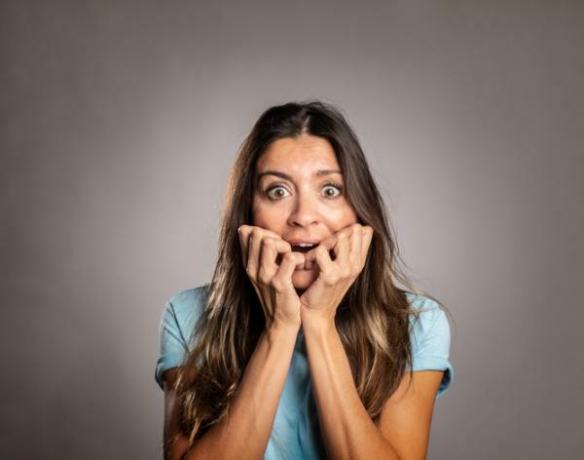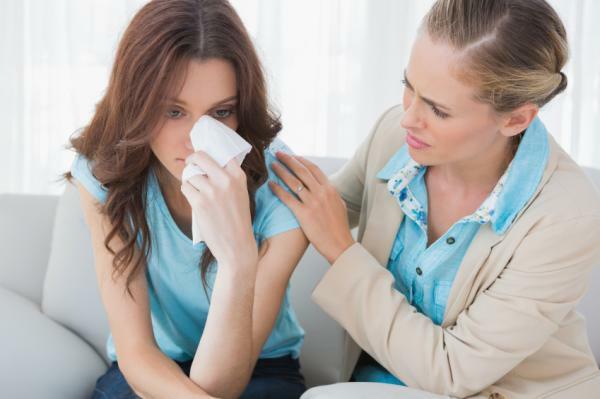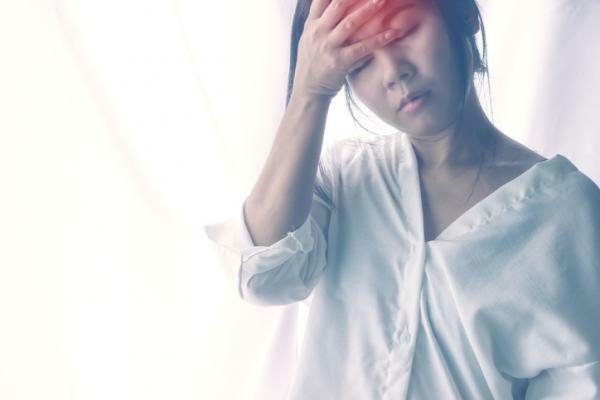
What is fear in psychology? Fear is an emotion that alters both perception and reasoning when faced with certain events or situations. Why are we afraid? What is fear for? Adaptive fear serves to protect us against threatening situations, however, when fear is dysfunctional, it can complicate our lives. Dysfunctional fears can generate distressing disturbances in the presence of damage (real or imagined). In this sense, fears are experienced in a habitual way in people, but it is necessary to know to what extent it is a normative fear and adequate and, on the contrary, when this psychological fear crosses the border and is considered an excessive fear it can become a phobia. Is it possible to live without fear? No, but it is possible to regulate fear.
There are many types of fears, do you want to know if your greatest fear is among the 20 most common types? Then do not hesitate to continue reading this article from Psychology-Online: 20 most common types of fear and their characteristics, where you will find a list of fears.
Index
- Arachnophobia
- Apiphobia
- Ornithophobia
- Zoophobia
- Entomophobia
- Agoraphobia
- Hematophobia
- Brontophobia
- Claustrophobia
- Scotophobia
- Hydrophobia
- Aerophobia
- Acrophobia
- Carcinophobia
- Thanatophobia
- Glossophobia
- Amaxophobia
- Trypophobia
- Harpaxophobia
- Coulrophobia
- Overcoming fear: treatment
1. Arachnophobia.
Arachnophobia refers to fear of spiders. It is one of the most common specific phobias, understanding specific phobia as an anxiety disorder in which the afraid it appears due to the presence or anticipation of a feared object or situation, in this case, spiders.
Arachnophobia: symptoms
The symptoms of arachnophobia can appear before the vision of spiders or in anticipation, that is, before viewing them, for example, if the person approaches a site that they have previously seen spiders. Thus, people with arachnophobia usually present some of the following symptoms: avoidance, nausea, anxiety, sweating, rapid heartbeat, crying, among others.
2. Apiphobia.
One of the most common types of fear is apiphobia. The term apiphobia refers to fear of beesand the wasps. It is a fear very similar to arachnophobia, although in this case spiders are exchanged for bees and wasps. People who are afraid of these insects experience symptoms that are very similar or identical to the symptoms suffered by people with fear of spiders. It is a very common fear. What causes fear, the fact that people cannot have control of those insects and they cannot be undone with a simple footstep, a fact that increases the chances of receiving a bite.
3. Ornithophobia.
The fear of birds or ornithophobia refer to another of the most common fears, to which people respond, when faced with presence of birds, with symptoms of anxiety (sweating, tachycardia, accelerated rhythm cardiac…). In this case, as in apiphobia, people do not have control of these animals, a fact that can promote greater anxiety. The fear of birds can be directed both at predatory birds (eagles ...) and harmless birds (pigeons, parakeets ...).
4. Zoophobia
what's the name of the phobia to the animals? Zoophobia Zoophobia includes all the most common fears directed towards animals. Within zoophobia are both arachnophobia and apiphobia and ornithophobia, these being the most common. However, fears of other animals are also included, such as phobia of animals. dogs (cinophobia), phobia of cats (ailurophobia), phobia of horses (hypophobia), irrational fear of snakes (ophidiophobia), phobia of sharks (selacophobia), among others. This type of fear can be explained by the experience of a traumatic situation with a specific animal or, on the contrary, it can be an irrational and inexplicable fear.
5. Entomophobia
Following the thread of fear of animals, entomophobia must be taken into account, which refers to fear of insects in general. It is one of the most common types of fear that is included within zoophobia. However, within entomophobia you can find different types of fear, among which are the fear of bees (apiphobia), the fear of ants (myrmecophobia), fear of butterflies (motephobia), among others.
6. Agoraphobia.
Another of the most common types of fear is agoraphobia, considered an anxiety disorder. People with agoraphobia are afraid of two or more of the following situations: ride public transport, be in open or enclosed spaces, queue (for example, at a supermarket checkout), being in a crowd, being alone outside the home in other situations. When these situations generate excessive fear, the people who suffer it usually avoid this type situations and, to deal with them, the presence of somebody is almost always necessary. companion.
Agoraphobia: symptoms
People are often fearful in these situations due to disabling thoughts and symptoms or humiliating in circumstances in which escape would be difficult or in circumstances in which the person is aware that no help would be available. Some of these thoughts and symptoms may include the following: dizziness, fainting, sweating, tremor, rapid heartbeat, palpitations, rapid heart rate, feeling short of breath, feeling short of breath, pain or discomfort in the chest, nausea, instability, derealisation (feeling of unreality), fear of losing control, fear of dying, among others.
7. Hematophobia.
Another of the most common specific phobias is hematophobia. In this case, fear is directed at the vision of blood, needles and wounds, although rather, fear is directed towards fear by the anticipation of unpleasant consequences of situations in which needles, blood and / or wounds are witnessed, such as dizziness or Fainting. Thus, in this type of fear there are also avoidance and / or escape behaviors, related to places, objects and situations, such as blood donation room, hospital, violent movies, among others.
The physiological responses or the most notable physical symptoms of hematophobia or blood phobia are divided into two phases. In the first phase there is a increased heart rate, blood pressure and respiration. Then, in the second and final phase, there is a rapid decline of these three aspects already mentioned, especially heart rate and blood pressure. This abrupt decrease is what can lead people to dizziness and, sometimes, to Fainting to see blood.
8. Brontophobia.
Another of the most common types of fear is brontophobia. What is the meaning of brontophobia? Brontophobia refers to fear of weather phenomenasuch as storms, thunder and lightning. In cases of not excessive fear, people may feel anxiety and / or discomfort. However, in extreme cases of fear of meteorological phenomena, people's daily lives can be interfered with, since At times of the year when these phenomena are more common, people may feel completely unprotected, a fact that leads them to to be unable to perform ordinary activities of their day to day, such as getting up and going to work, going out to buy bread, among others.
9. Claustrophobia.
Claustrophobia is one of the most common types of fear. It consists of the fear of be in a closed space. Although there are different types of claustrophobia, in general, claustrophobic people will try escape or avoid situations such as the following: being in small rooms or without windows, using the elevator, wearing a full-face helmet (of which cover the entire face), and other situations in which they are in closed or small places that cause the sensation from difficulty escapingThe difficulties that people who have this fear present are breathing difficulties, fear of suffocation, restriction or inability to move or leave a place, fear of having a panic attack, fear of getting hurt due to nerves, fear of losing control or going crazy, among others. In addition, these people also tend to perform defensive behaviors to reduce the intensity of their fear, such as leaving a window open, not putting the door latch, and so on.
10. Scotophobia.
Scotophobia is defined as the fear of the dark. It is a very common fear in childhood, although it can also be suffered in adulthood. If the fear is very persistent, it can significantly interfere with the development of the individual and affect considerably to family functioning, especially when it comes to a fear of the dark in childhood, since, in some Sometimes, in order to get the child to sleep, inappropriate solutions are carried out, such as letting the child sleep with parents.
11. Hydrophobia.
Another of the most common types of fears is hydrophobia. The meaning of hydrophobia is to experience fear of water. It is not about water as a drink, but from the sea or pool water, where people can swim. People with this type of fear are afraid of falling into the water, being pushed, not being able to swim and choking or drowning if they swallow water, among others. For this reason, people who are afraid of water, avoid going to the beach or places where they can be in front of a pool. However, in cases where they are faced with a feared situation, the behaviors that they usually carry out to reduce their fear They are: carry a float or inflatable that allows them not to drown, be accompanied by a trusted person, do not enter the water and remain in the Bank.
12. Aerophobia.
The fear of flying in airplanes it is commonly called aerophobia or fear of flying. Two types of people who are afraid of flying can be distinguished: people who avoid flying and people who do so with intense and considerable discomfort. Within this fear you can find other fears that vary depending on each person, such as thinking about the possibility of having an accident (therefore, fear of getting hurt dying in the accident), being locked up for a certain time in a space small, dizziness and nausea due to the instability of the plane, altitude, not being in control or losing it (for example, screaming), between others.
13. Acrophobia.
Another of the most common types of fear is acrophobia. Acrophobia is characterized by being the commonly called fear of heights. There are different aspects that can promote this type of fear in people, such as the distance they are from the ground, transparent ground or with grating (not solid ground), lack of railings, looking down, certain theme park attractions, leaning out of a balcony or window, between others.
People with a fear of heights, as in so many other fears, usually avoid finding themselves in situations where they are at a certain unevenness in relation to the ground. However, when people cannot avoid these situations, they tend to respond to them with psychological discomfort and symptoms of anxiety. In this article you will find how to overcome fear of heights.
14. Carcinophobia
Carcinophobia or fear of cancer, is characterized by the presence of anxiety before medical tests, the search for information about the disease, among others. In this sense, carcinophobia can negatively affect the well-being and quality of life of people who suffer from this fear. On the one hand, it can be a fear of developing a relapse or the reappearance of a tumor of a disease already suffered previously. On the other hand, it can be a fear of developing the disease without ever having suffered it before.
15. Thanatophobia
Another of the most common types of fear is thanatophobia. Thanatophobia is known as the fear of death, caused by the presence or anticipation of objects or situations related to death (coffin, hearse, funeral home, funeral, ...). The fact of witnessing situations or objects related to death causes anxiety in people with thanatophobia. It is common for these people to try to avoid situations of this type. Normally people who suffer from fear of death are people who are in a vital period close to the end of life.
Thus, they are usually the elderly or those with a disease serious and incurable those who usually suffer this type of fear. Therefore, it could be said that thanatophobia is closely related to carcinophobia (fear of cancer) or to fear of falling ill, either due to cancer or any other serious illness that endangers the life of the person.
16. Glossophobia.
Glossophobia or Scared of speaking in public, is one of the most common types of fear among adult and adolescent students who are dedicated to making conferences, exhibitions and else. People with this type of fear consider that having to appear before an audience and speak is one of the most difficult situations to which they are exposed. The fear of public speaking is an anxiety response to different aspects (the public's reaction, the teacher's evaluation, etc.). In this article you can find how to lose the fear of public speaking.
17. Amaxophobia.
Amaxophobia is defined as fear of driving, both during and before driving, that is, fear also appears in advance of action. These people can show that they have a great fear of having an accident, getting hurt, queuing in a traffic jam with the feeling of being trapped, aspects of the road (curves, potholes, slope ...), speed, among others.
It should be noted that people who feel anxiety when taking the car but achieve driving it does not suffer amaxophobia, it is simply a slight fear of driving but easy overcoming. On the other hand, when people suffer from excessive and disabling fear, it can be considered amaxophobia.
18. Trypophobia.
Trypophobia is characterized by fear of repetitive succession of geometric figures very close together and in large quantities, especially if it is small gaps and / or holes (for example, a honeycomb). These are patterns of geometric shapes that have an asymmetrical look. People who have this type of fear show to express repulsion and / or anxiety in the face of this type of pattern.
19. Harpaxophobia.
Another of the most common types of fear is hapaxophobia. Hapaxophobia is the fear of someone entering the house, fear of thieves or to be robbed. Crime is perceived as a threat that makes people feel insecure and / or defenseless from potential aggressors. In this sense, the fear of thieves or of being robbed goes further, since it is closely related to the fear of the possibility or of people's perception of being violently attacked. Therefore, it can be closely related to the experience of previous experiences, depending on whether previously we have been robbed with or without violence or, on the contrary, if we have never been stolen or, we create ideas related to movies, experiences of friends or family, among others.
20. Coulrophobia.
Coulrophobia is the name for the fear of clowns. This type of fear can be teased by other people, especially when it comes to children, but People who suffer from this fear really go through unpleasant and negative situations when they see the figure of a clown. These people generally experience anxiety, tremors, malaise, feeling of intense fear, tachycardia, rapid heart rate, breathing difficulties, among others. People with a fear of clowns try to avoid being in situations where they may run into such figure, but in the child population it is more difficult to avoid, since it is a very common figure at festivals birthday.
Overcoming fear: treatment.
There are psychological treatments to overcome fear, the most common: exposure, a technique cognitive-behavioral which has shown good results in the treatment of phobias. How to know if it is necessary to go to a specialist? The different types of psychological fears need to be treated by specialists when they:
- They are experienced disproportionately: intense and excessive fears, which can become incapacitated.
- They do not have a logical explanation: patients are aware of how absurd their fear can be but, even so, they are unable to overcome it.
- They are uncontrollable: when fears are beyond the patient's reach and he is unable to voluntarily control them.
- They try to avoid: when patients understand that the only way to feel good is to avoid their fears and everything that can cause them.
This article is merely informative, in Psychology-Online we do not have the power to make a diagnosis or recommend a treatment. We invite you to go to a psychologist to treat your particular case.
If you want to read more articles similar to 20 most common types of fears and their characteristics, we recommend that you enter our category of Clinical psychology.
Bibliography
- American Psychiatric Association. (2014). Diagnostic and Statistical Manual of Mental Disorders. DSM 5. 5th Edition. USA: Pan-American
- Bados, A. (2009). Specific phobias. Universitat de Barcelona, Faculty of Psychology, Department of Personality, Avaluació i Tractament Psicològics.
- Borda, M. (2001). Hematophobia: synchrony in the triple response system. Journal of Clinical Psychology and Psychology, 6 (3), 179-196.
- Borda, M., Pérez, M.Á., and Avargues, M.L. (2011). Cognitive-behavioral treatment in a case of death phobia. Behavior Analysis and Modification Magazine, 37 (155-156), 91-114.
- Carmilo, L., Ropero, F.J., and Garcia, M. (2005). It isThere is no Brazilian context of three questions to assess arachnophobia.Psychological Assessment, 4(2), 125-139.
- Lechner, N. (1998). Our fears. Latin American Profiles Magazine, 7 (13), 179-198.
- Maldonado, I., and Reich, M. (2013). Coping strategies and fear of public speaking in college students at grade level. Journal of Psychological Sciences, 7 (2), 165-182.
- Reguillo, R. (2006). The fears: their labyrinths, their monsters, their spells. A socio-anthropological reading. Contemporary Ethnographies, 2 (2), 45-72.


